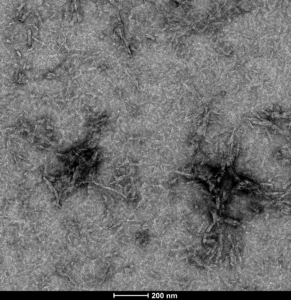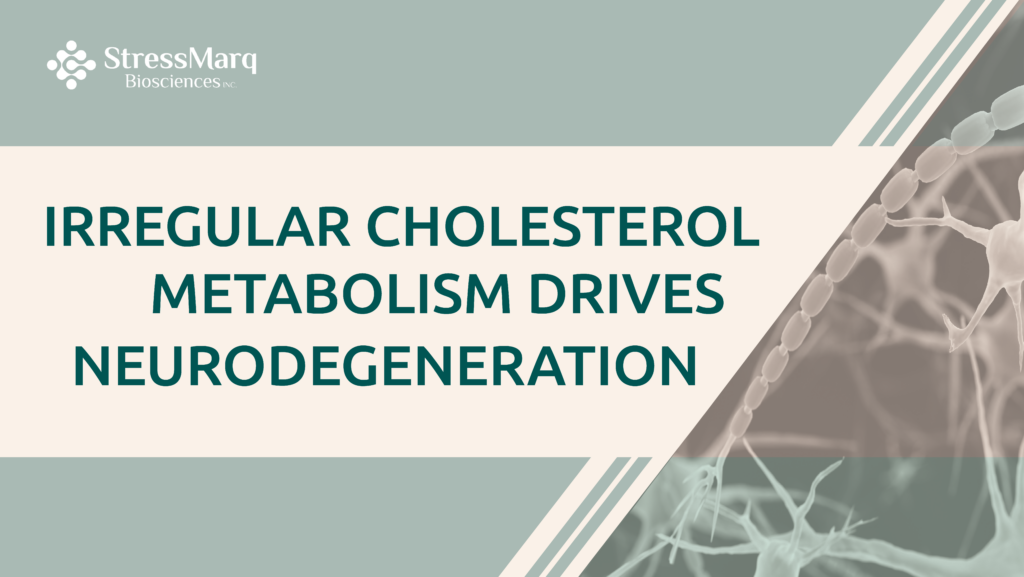Irregular Cholesterol Metabolism Drives Neurodegeneration
It has long been established that aging is a key risk factor for the development of several neurodegenerative diseases. As the general population ages, the global prevalence of these diseases has significantly increased, accompanied by intensified research efforts to develop therapies that counteract their devastating effects.
In Alzheimer’s disease (AD), the amyloid beta protein aggregates to form extracellular amyloid plaques. This process occurs alongside the hyperphosphorylation and aggregation of the tau protein, resulting in the formation of intracellular neurofibrillary tangles. As this pathological activity progresses, synaptic dysfunction and neuronal loss can be observed in the brain regions responsible for cognitive processes.
The resulting cognitive impairment is one of the most well-known symptoms of AD, along with increased difficulty in performing motor tasks. Neuroinflammation plays a crucial role in driving the progression of neurodegenerative diseases. Microglia — the resident immune cells of the central nervous system — are essential mediators of this neuroinflammatory process.
Cholesterol metabolism is regulated by Ch25h
In response to neuronal injury, microglia are activated to either secrete agents that promote inflammation or anti-inflammatory neuroprotective factors that assist with tissue repair. Genetic factors also play an important role in Alzheimer’s disease. Cholesterol metabolism and the immune response have been implicated as major genetic risk factors for late-onset Alzheimer’s disease. Research has show that these processes are involved in the transition of the microglial phenotype from normal to disease-associated microglia (DAM).
The enzyme cholesterol 25-hydroxylase (Ch25h), a key player in regulating cholesterol metabolism, is also a DAM gene. In the brains of patients with Alzheimer’s disease, Ch25h is upregulated alongside similar DAM genes. This led researchers to hypothesize whether Ch25h deficiency could suppress microglial activation and consequently, neurodegeneration. A new publication in the Journal of Experimental Medicine reveals that in the absence of Ch25h, proinflammatory signalling in microglia and neurodegenerative processes are reduced. These new results suggest that Ch25h may represent a promising therapeutic target for Alzheimer’s disease and other tauopathies.
Elevated Ch25h expression in an Alzheimer’s disease model
Previous research from the same group demonstrated elevated Ch25h mRNA expression in the frontal cortex of both Alzheimer’s disease patients and a mouse model of tau-driven neurodegeneration. To build on these findings, a new study was designed to gain cell-specific insights and further explore the relationship between Ch25h and disease-associated microglia (DAM) in the context of neurodegenerative diseases.
To investigate cellular localization, the researchers examined Ch25h protein levels and cell markers in the frontal cortex of brain tissues from patients at various stages of Alzheimer’s disease. They found that Ch25h protein levels were notably higher in the advanced stages of the disease, suggesting that tau pathology might trigger Ch25h expression. Over 90% of the Ch25h immunoreactivity was associated with microglial activation.
This pattern was successfully replicated in the PS19 tau mouse model, which overexpresses a mutant form of human tau with the P301S mutation linked to early-onset frontotemporal dementia. RNA in situ hybridization at 9.5 months revealed a 3- to 4-fold increase in Ch25h mRNA expression in the tau model compared to wild-type mice. This increase was accompanied by a significant uptick in neuroinflammatory processes.
Researchers then confirmed that the elevated Ch25h expression resulted in higher levels of its enzymatic product. Ch25h normally converts cholesterol into 25-hydroxycholesterol (25-HC), an oxysterol that regulates immune responses. Mass spectrometry analysis indicated that Ch25h expression in the tau model was associated with a significant rise in 25-HC production, while levels of other oxysterol isomers remained unchanged, indicating that the increase was representative of Ch25h activity levels.
Ch25h deficiency affects microglial responsiveness
Prior to the study, evidence had already accumulated to suggest that amyloid beta plaque accumulation and tau aggregation played a significant role in the activation of disease-associated microglia. The researchers revealed that Ch25h deficiency decreased the progression of reactive microglia to a disease-associated microglial state without enabling a complete reversion to the homeostatic state.
Furthermore, transcriptomic data highlighted the role of proinflammatory pathways in regulating tau-mediated neuroinflammation. Ch25h deficiency in tau transgenic mice successfully downregulated transcription regulators involved in the inflammatory response, including the NFκB family.
Role of tau fibrils in the proinflammatory response
To conclude the study, it was important to define how the lack of Ch25h influences proinflammatory signalling pathways in tau transgenic mice. Inflammatory signalling processes were subsequently investigated in activated microglia. Ch25h deficiency reduced the downstream targets of NFκB signalling and the inflammatory response, and confirmed the modulatory role of Ch25h in neuroinflammation.
Inflammatory activation of microglia was also linked to microglial phagocytosis. To demonstrate this process, StressMarq’s Tau-441 (2N4R) P301S Mutant PFFs: ATTO 488 (catalog# SPR-329-A488) were utilized to analyze the phagocytic ability of the microglia. Colocalization between the fluorescent-tagged tau fibrils and a phagolysosome marker (CD68) revealed no difference in the ability of microglia to phagocytose tau fibrils under Ch25h deficient conditions.
Finally, to examine induction of the inflammatory response in microglial in mouse primary microglia, StressMarq’s Tau-441 (2N4R) P301S Mutant PFFs (Baculovirus/Sf9) (catalog#SPR-471) were employed. Following treatment with the tau fibrils, qPCR gene expression analysis assessed the relative expression of genes related to the inflammatory response. The data suggested that tau fibrils induced a proinflammatory response that could be suppressed in the absence of Ch25h.
Examining microglial activation using StressMarq products
The study by Toral-Rios et al. depicts the first evidence supporting the role of Ch25h in microglial activation to promote neuroinflammation and neurodegeneration. Due to the increasing prevalence of neurodegenerative diseases, characterising the cellular processes and modulators of disease progression remains vital to identifying novel therapeutic avenues. StressMarq’s Tau-441 (2N4R) P301S Mutant PFFs: ATTO 488 (catalog# SPR-329-A488) were critical in elucidating the process of microglial phagocytosis. In tandem with qPCR gene expression analysis, StressMarq’s Tau-441 (2N4R) P301S Mutant PFFs (Baculovirus/Sf9) (catalog# SPR-471) pinpointed the role of Ch25h in the induction of an inflammatory response by microglia.

[Image from: StressMarq website] Visualizing fibrillar structures through TEM imaging of StressMarq’s Tau-441 (2N4R) P301S Mutant PFFs (Baculovirus/Sf9) (catalog# SPR-329-A488).
Summary
The development of neurodegenerative diseases enables microglia to shift from a homeostatic state to a disease-associated microglial (DAM) state through the activation of various signalling pathways. Immunohistochemical and gene expression studies further suggest that DAMs are closely linked to regions affected by Alzheimer’s disease pathology. Two major genetic risk factors for Alzheimer’s disease are cholesterol metabolism and immune regulation, both of which are related to DAMs. Toral-Rios et al. successfully shed light on how Ch25h impacts tau-driven neuroinflammation and neurodegeneration. In a mutant tau model of neurodegeneration, Ch25h deficiency reduced proinflammatory responses in microglia.
Overall, the findings support the role of Ch25h and its product, 25-HC, in enhancing proinflammatory signalling and contributing to tau-related neurodegeneration. Targeting Ch25h may offer a promising therapeutic strategy for addressing neurodegeneration-specific microglial activation, potentially leading to new treatments for tauopathies and other neurodegenerative conditions.
Related StressMarq products
StressMarq is committed to providing high-quality reagents to support neurodegenerative research with a wide range of oligomeric, fibrillar and monomeric protein preparations. Visit our website for more information, including the latest scientific publications using our specialized alpha synuclein, tau and amyloid beta proteins for neurodegenerative disease research.
References
- Cholesterol 25-hydroxylase mediates neuroinflammation and neurodegeneration in a mouse model of tauopathy. Toral-Rioss, D. et al. JEM. 2024.


Leave a Reply